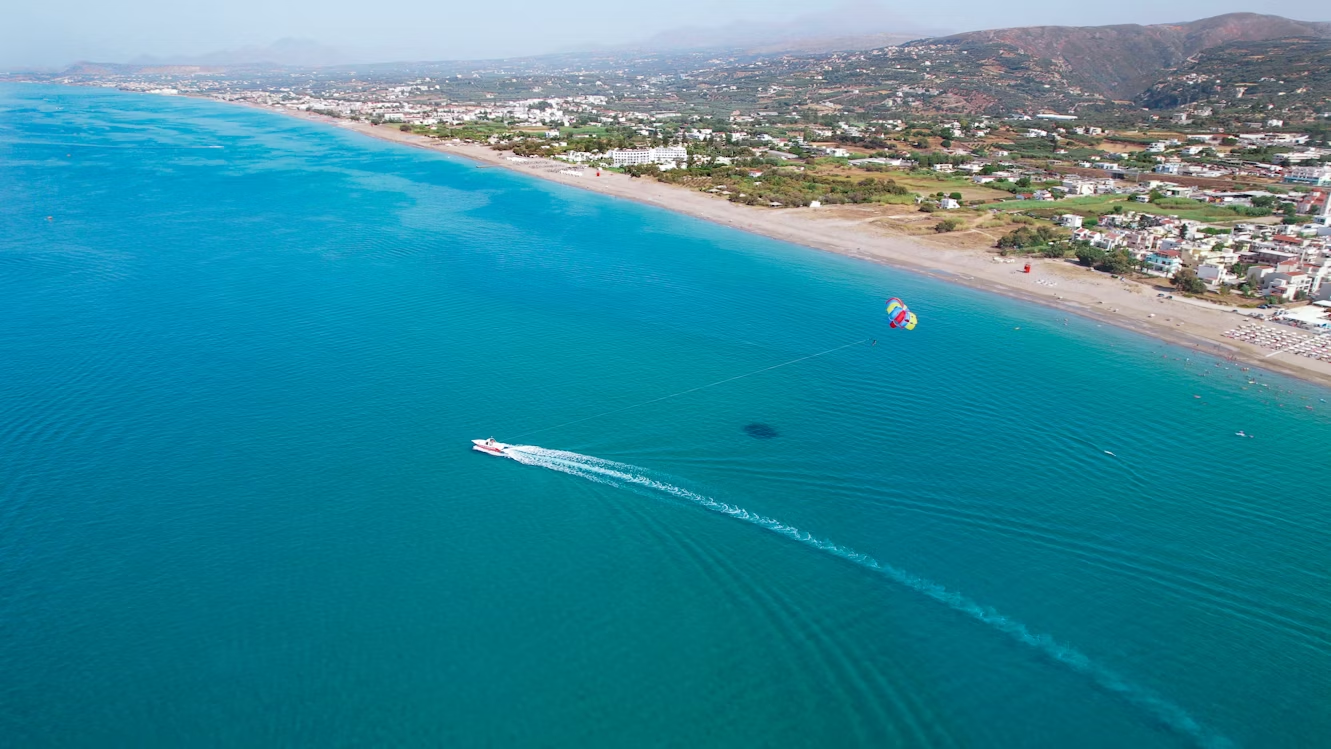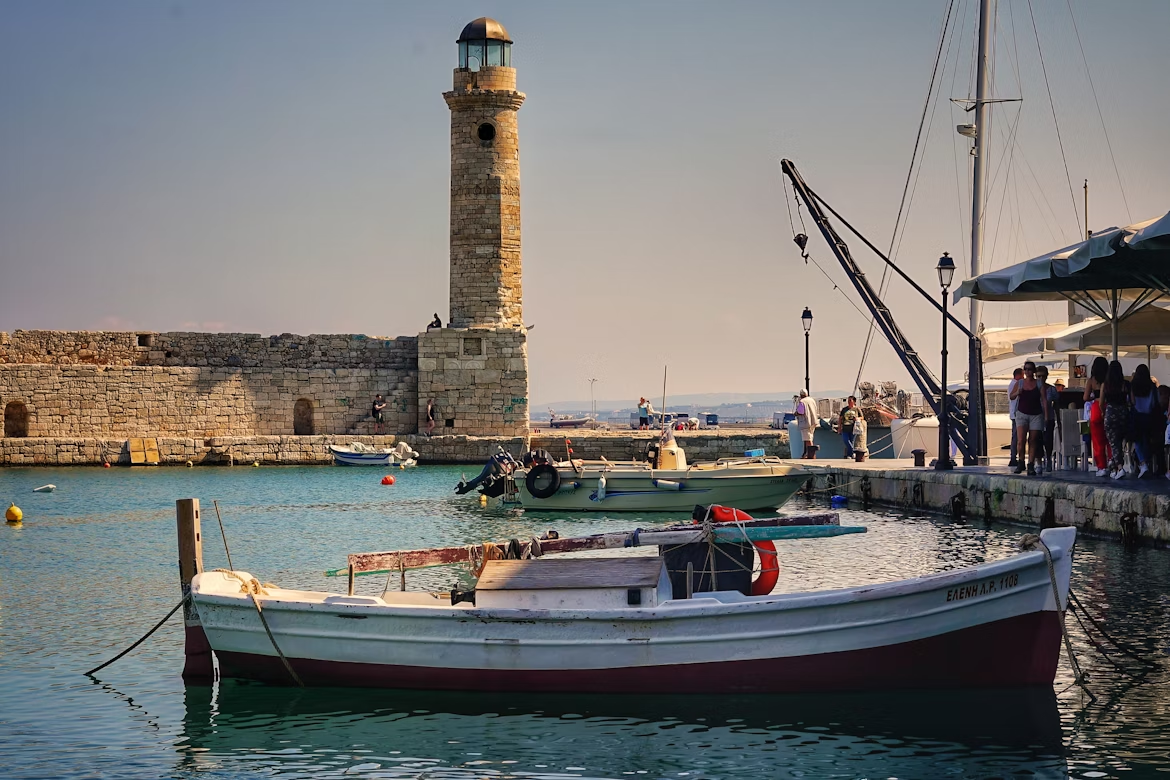Travelling from Rethymno to Santorini: Ferry & Travel Guide
Travel Guides
Travel Guides


Embarking on a journey from Rethymno to the stunning island of Santorini (Thira) is one of the most sought-after Greek island-hopping experiences. This picturesque route connects Crete's charming northern coast with one of the most iconic destinations in the Aegean Sea. While flights might require connecting through Athens, the direct ferry route offers a convenient and scenic alternative, allowing travellers to experience the magnificent blue waters of the Mediterranean. At approximately 146.9 km (91.3 miles) across the Aegean Sea, this journey combines convenience with breathtaking views.
This comprehensive guide covers everything you need to know about travelling between these two popular Greek destinations, with a focus on the ferry services that connect them.
When planning your trip from Rethymno to Santorini, you have two main transportation options to consider, though the ferry is the most direct choice.
For those considering flights, it's important to note that Rethymno doesn't have its own airport. You would need to travel to either Chania or Heraklion airports on Crete, then take a flight to Santorini with a possible connection through Athens. This option involves additional ground transportation and potentially multiple flights, making it less direct than the ferry option.
The ferry route is the more straightforward choice. SeaJets operates this route with regular sailings during the summer season. The journey covers 79.3 nautical miles across the beautiful Aegean Sea. The ferry takes approximately 2 hours and 20 minutes, making it a relatively quick sea crossing considering the distance. With ticket prices averaging around £408, the ferry offers a premium but direct connection between these popular destinations.
While flights might seem faster at first glance, when you factor in the time needed to reach the airports, check-in procedures, potential connections, and then travelling from Santorini's airport to your final destination, the total journey time often ends up being comparable to the ferry. Additionally, the ferry journey offers spectacular views of the Aegean Sea and approaching Santorini's dramatic caldera - an experience that simply can't be matched when arriving by air.
You can take a ferry from Rethymno to Santorini. Ferries sail in around 2 hours and 20 minutes with about 1 sailing a day. The fastest ferry sails in around 2 hours and 20 minutes and is provided by SeaJets. Ferry prices average around £408 depending on the time of year. Departures start at 08:00, with the last departure from Rethymno to Thira at 08:00.
SeaJets is the primary operator serving this route, offering modern, high-speed vessels that make the crossing comfortable and efficient. Their fleet typically includes amenities such as comfortable seating areas, cafés serving refreshments and light meals, and outdoor deck space where you can enjoy the sea breeze and spectacular views.
It's worth noting that this ferry route is seasonal, typically operating during the summer months when tourism to the Greek islands peaks. Service usually runs from late May through September or early October, though exact schedules can vary year to year. We recommend checking the latest timetables when planning your trip.
The ferry journey itself is a treat for travellers. As you leave the port of Rethymno behind, you'll enjoy views of Crete's coastline before venturing into the open Aegean. The approach to Santorini is particularly spectacular, with the island's famous cliff-top white buildings coming into view against the dramatic volcanic landscape.
Onboard the SeaJets ferries, you can expect air-conditioned interiors, comfortable seating, and basic amenities to make your journey pleasant. Some vessels offer different seating classes, from standard to VIP options, allowing you to choose the level of comfort that suits your preferences and budget.

Rethymno's port is conveniently located near the heart of the city, making it easily accessible for travellers. The port is within walking distance from the old town and many hotels, particularly those along the waterfront. If you're staying further away, local buses connect various parts of the city to the port area, or you can easily find taxis at reasonable prices.
If you're arriving by car, there is parking available near the port, though spaces can be limited during peak season. We recommend arriving at least an hour before your scheduled departure to allow time for parking, checking in, and boarding procedures.
The port facilities in Rethymno are relatively basic but functional. You'll find a small waiting area, some shops and cafés nearby where you can purchase snacks or drinks before boarding. There are restrooms available, and the port staff are generally helpful with directions and information.
The check-in process is straightforward - present your booking confirmation at the ferry operator's counter to receive your boarding pass. The boarding area is clearly marked, and announcements are typically made in both Greek and English.
Arriving at Santorini's Athinios Port (the main ferry port on the island) can be busy, especially during peak season. The port is located at the bottom of a steep cliff, with the main towns of the island situated at the top.
From the port, you have several transportation options to reach your final destination on the island. Public buses connect the port to Fira (the capital) and from there to other parts of the island. These buses are timed to meet arriving ferries, but they can get crowded quickly.
Taxis are available but limited in number and can be in high demand when ferries arrive. Many hotels offer pickup services from the port, which we highly recommend arranging in advance to avoid the post-arrival rush.
Rental car agencies have desks at or near the port, which can be convenient if you plan to explore the island independently. However, during peak season, it's advisable to book your rental car in advance.
The port itself has basic facilities including restrooms, a few snack bars, and souvenir shops. There's limited seating in the port area, so if you have a wait before your onward transportation, you might want to visit one of the cafés near the port.
While it's technically possible to make a day trip from Rethymno to Santorini, the limited ferry schedule makes this challenging and we wouldn't generally recommend it for most travellers. With only one daily sailing departing Rethymno at 08:00, and considering the 2 hour and 20 minute journey each way, you would have limited time on the island before needing to return.
The return schedule would also be a key factor, and since schedules can vary seasonally, you would need to carefully check if there's a same-day return option during your planned visit. In many cases, there may not be a direct return ferry on the same day.
If you're determined to see Santorini as a day trip from Rethymno, we recommend booking an organised tour instead. Several companies offer day excursions that use faster transportation methods or have arranged return transportation that might not be available to independent travellers.
For a more enjoyable experience, we suggest staying at least one night on Santorini. This allows you to experience the island's famous sunset, explore at a more relaxed pace, and avoid the rush of trying to fit everything into a few hours. Even a one-night stay would give you essentially two days to explore the island's highlights.
If your schedule doesn't allow for an overnight stay in Santorini but you're still looking for a day trip from Rethymno, consider exploring other parts of Crete instead. Destinations like Knossos, Chania, or the beaches of the south coast make excellent day trips and don't require the longer ferry journey.

Santorini offers an abundance of activities and sights that showcase its unique volcanic landscape, stunning architecture, and rich cultural heritage. Here are the top attractions you won't want to miss:
The island's famous caldera offers some of the most spectacular views in the world. Head to Oia, Fira, or Imerovigli to find the perfect spot to take in the vast volcanic basin filled with deep blue water. These viewpoints are accessible throughout the day, but sunset hours transform the landscape into a truly magical experience.
Often called Greece's Pompeii, this remarkably preserved ancient Minoan city was buried under volcanic ash around 1600 BCE. Today, you can walk through the excavated ruins and see multi-story buildings, drainage systems, and pottery from this advanced Bronze Age civilisation. Open daily (except Tuesdays) from 8:00 to 20:00 during summer months.
This stunning beach is backed by soaring red cliffs that create a dramatic contrast with the blue waters. While swimming is possible, many visitors come simply to photograph the unique landscape. Located near Akrotiri, it's accessible by a short (somewhat rocky) path from the nearby parking area.
Perched on Mesa Vouno mountain, this ancient city offers both historical interest and panoramic views. You'll find ruins from the Hellenistic, Roman, and Byzantine periods, including temples, houses, and a theatre. Open from 8:30 to 15:30 (closed Tuesdays), it's accessible via a winding road from Kamari or by hiking trail.
Santorini's volcanic soil produces distinctive wines, particularly the crisp, mineral-rich Assyrtiko. Numerous wineries across the island offer tours and tastings, with Santo Wines, Venetsanos, and Domaine Sigalas being among the most popular. Most are open daily during the tourist season, typically from 10:00 to sunset.
Santorini's unique architecture and village layouts are a significant part of its charm. Each area offers a different experience:
Fira, the island's capital, is the busiest hub with shopping, dining, and nightlife concentrated along its caldera-edge pathways. The central location makes it an excellent base for exploring the island.
Oia, at the northern tip of the island, is famous for its sunset views, blue-domed churches, and upscale shopping. More serene than Fira during the day, it becomes extremely crowded around sunset.
Imerovigli, sometimes called the balcony to the Aegean, offers some of the highest and most unobstructed caldera views. This quieter village is perfect for those seeking stunning vistas without the crowds.
Pyrgos, one of the island's inland villages, provides a glimpse into more traditional Greek island life with its well-preserved castle, winding lanes, and local tavernas. It's a refreshing alternative to the more tourist-focused caldera villages.
Kamari and Perissa feature the island's famous black sand beaches lined with restaurants and beach bars. These areas offer a more conventional beach holiday experience alongside the island's unique attractions.
Santorini enjoys a Mediterranean climate with distinct seasonal variations that can significantly impact your visit. Understanding the weather patterns will help you plan the ideal trip.
Summer (June to September) brings hot, dry conditions with temperatures typically ranging from 23°C to 29°C (73°F to 84°F). July and August are the hottest months, with temperatures occasionally reaching above 30°C (86°F). These months offer perfect beach weather and virtually guaranteed sunshine, but also bring the largest crowds and highest prices.
Spring (April to May) and autumn (October to early November) offer milder temperatures ranging from 15°C to 25°C (59°F to 77°F). These shoulder seasons provide a pleasant balance of comfortable temperatures and reduced crowds, making them ideal for sightseeing and hiking the island's trails.
Winter (November to March) is Santorini's quiet season. Temperatures typically range from 10°C to 15°C (50°F to 59°F), and the island receives most of its modest annual rainfall during these months. Many tourist facilities close, but the island offers a peaceful atmosphere and dramatically lower prices for the few visitors who arrive during this period.
Regarding ferry operations, weather can occasionally impact sailings, particularly during winter months when strong winds may cause delays or cancellations. The summer season generally sees stable conditions, though the occasional meltemi winds can cause rough seas. The SeaJets service between Rethymno and Santorini operates primarily during the summer season when weather conditions are most favourable.

Santorini is one of Greece's premium destinations, with prices reflecting its worldwide popularity and unique setting. Understanding the cost landscape will help you budget appropriately for your visit.
Accommodation costs vary dramatically depending on location, season, and amenities. A caldera-view hotel room in Oia or Fira during peak season can range from £200 to £1,000+ per night. More modest accommodations away from the caldera or in villages like Kamari might range from £70 to £150 per night. Visiting during shoulder seasons (May, early June, late September, October) can reduce these prices by 30-50%.
For meals, budget around £15-25 per person for a casual taverna meal with a drink. Upscale restaurants, particularly those with caldera views, can easily cost £50-100 per person. A quick gyros sandwich might cost £4-6, while coffee at a café typically ranges from £3-5.
Local transportation costs include bus rides between villages at approximately £2-3 per journey. Taxis have fixed rates between destinations, typically ranging from £10-25 depending on distance. Renting a small car costs around £40-60 per day during peak season.
For budget travellers, we recommend staying in less premium locations like Perissa or Kamari, eating at local gyros shops and tavernas away from tourist centres, and using the efficient local bus system. Budget-conscious visitors should allocate at least £100 per day excluding accommodation.
Mid-range travellers staying in decent hotels without caldera views and mixing casual and nicer dining experiences should budget £150-250 per day plus accommodation.
Luxury travellers enjoying premium caldera accommodations, fine dining, and private tours should expect to spend £300+ per day plus accommodation costs.
Choosing when to visit Santorini involves balancing weather conditions, crowd levels, and personal preferences. Each season offers a different experience of this iconic island.
Peak season (July and August) brings hot, sunny days perfect for beach activities and swimming in the Aegean. However, this is also when the island is at its most crowded and expensive. The narrow streets of Oia and Fira become congested, restaurants require reservations, and finding a spot to watch the famous sunset can be challenging. If you visit during this time, book accommodations months in advance and prepare for premium prices.
Shoulder seasons (May to June and September to early October) offer what many consider the ideal balance. Temperatures remain warm and pleasant (20-25°C/68-77°F), the sea is comfortable for swimming, and while still popular, the island sees fewer visitors than during peak months. Prices drop somewhat from their summer highs, and you'll have an easier time securing reservations at popular restaurants and sunset spots.
Low season (November to April) presents a completely different Santorini. Many businesses close, especially in smaller villages, and the ferry service from Rethymno typically doesn't operate during these months. However, visitors during this period experience a more authentic, peaceful island with dramatically lower prices. Winter brings cooler temperatures and some rainfall, but also magical misty views of the caldera and a chance to explore without crowds.
For first-time visitors wanting to experience Santorini's highlights with manageable crowds, we recommend late May, early June, or late September. Photography enthusiasts might appreciate the unique light conditions and dramatic skies of April or October. Budget travellers will find the best values in early May or mid-October when prices drop but most businesses remain open.
Santorini also hosts several events worth considering in your timing. The International Music Festival in September features classical performances in unique venues around the island. The Ifestia Festival in August commemorates the volcanic eruption with fireworks over the caldera. Wine enthusiasts might time their visit for the grape harvest in late August and early September when many wineries hold special events.

Finding the perfect place to stay in Santorini can enhance your Greek island experience after your ferry journey from Rethymno. The island offers accommodations for every budget and preference.
For budget-conscious travellers, look for guesthouses and small hotels in Fira town centre, where prices start from around £50 per night. These provide convenient access to restaurants, shops, and public transportation.
Couples seeking romance might prefer the iconic cave hotels in Oia or Imerovigli, with their stunning caldera views. These boutique accommodations typically range from £100-300 per night depending on the season.
Families will find suitable options in Kamari and Perissa, where beach-adjacent hotels offer child-friendly amenities and more space. Many include kitchenettes for self-catering, with prices from £80-150 per night.
For the best rates, consider booking well in advance, especially if travelling during the peak summer months when SeaJets operates the ferry service between Rethymno and Santorini.
Navigating Santorini efficiently will help you make the most of your island stay after disembarking from your ferry from Rethymno.
The local bus network (KTEL) connects major towns and attractions, with Fira serving as the central hub. Buses are affordable (€1.80-2.50 per journey) but can become crowded during peak season.
Taxis are readily available but relatively expensive due to limited numbers on the island. Consider pre-arranging airport or port transfers to avoid waiting times.
Renting a car, motorbike, or ATV gives you the freedom to explore at your own pace. Daily car rental rates start from approximately £40, while ATVs cost around £25-35 per day.
Walking is pleasant within individual towns, especially along the picturesque caldera path connecting Fira, Imerovigli, and Oia. However, the distance between towns makes some form of transport necessary for island exploration.
Many visitors combine transportation methods, perhaps using buses for longer journeys and exploring towns on foot to fully appreciate Santorini's breathtaking scenery.
The ferry journey from Rethymno to Thira (Santorini) offers an excellent way to experience the beauty of the Aegean Sea while travelling between these two stunning Greek destinations. With SeaJets providing a swift 2 hour 20 minute crossing covering 79.3 nautical miles, this sea route combines convenience with spectacular views.
Remember that this ferry service operates seasonally, with one sailing per day departing at 08:00. With weekly sailings and approximately 7 monthly crossings, planning ahead is essential to secure your preferred travel dates.
At £408 for the crossing, the ferry represents good value considering the experience and the seamless port-to-port journey between Crete and Santorini. The morning departure time allows you to arrive in Santorini with plenty of daylight hours remaining to begin exploring this iconic island.
Ready to experience this remarkable journey across the Aegean? Book your Rethymno to Santorini ferry tickets now to secure your place on this popular route and begin planning your perfect Greek island adventure.